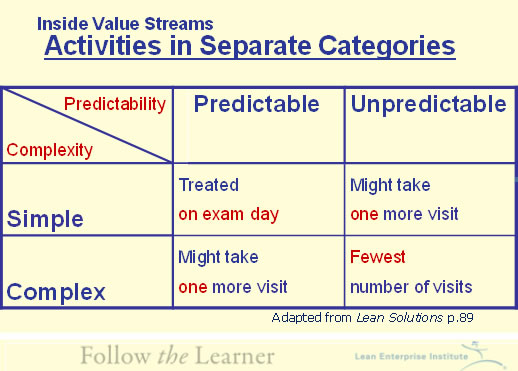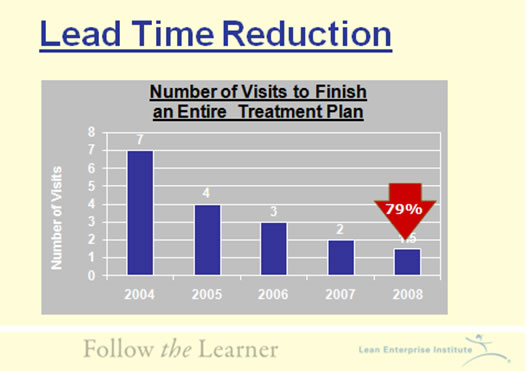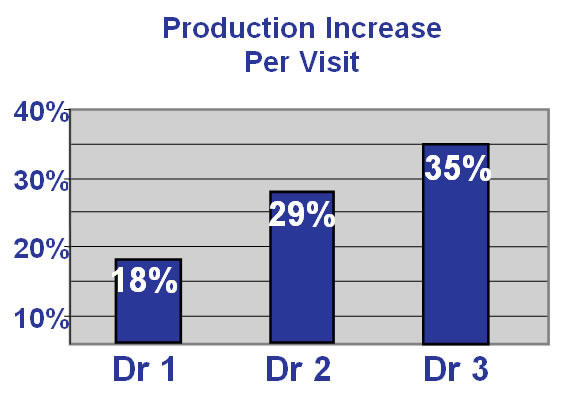At AME’s annual conference in Covington, KY, two weeks ago, Sami Bahri used his book, Follow the Learner, to base a great one hour keynote, the fascinating story of learning and applying lean thinking to his dental practice in Jacksonville, FL.
I first visited Sami at his clinic when he was fairly early in his journey. By then he had already installed most of the familiar pieces of a lean operating system in his clinic, but there were still PLENTY of bugs to work out (as always). So that condition actually made it a fun time to visit. What was most impressive at the time was the enthusiasm of Sami and staff. Actually, what was MOST impressive was the PASSION of Sami himself.
Sami learned about lean from books, starting with Lean Thinking and Learning To See, and then ran across fellow Jacksonville area lean enthusiast Jerry Bussell (who also gave an unforgettable keynote at this year’s AME), who introduced Sami to many others in the lean community (including me, so thanks Jerry).
What is most instructive for all of us about Sami’s story is that he was truly working through the application of lean thinking as a pioneer in his field. He had no role model for what lean might mean to a dental office. He had no sensei to help him. He just worked back from first principles, one at a time.
What does one-piece flow mean in a dental office? Is “one-piece” a patient, a mouth, a tooth, a cavity, a filling? What is one lot? How to figure out cycle times and takt times? How might heijunka work? What is pull?
Team involvement was never a question…
Today, Sami has some great advice for anyone looking to apply lean thinking to their business, especially anyone looking at application to a healthcare environment. After all, as one of the simplest of healthcare systems, a dental clinic is a healthcare system on a small scale – perhaps lessons learned there can provide a model for healthcare on a larger scale. Here are Sami’s rules:
- Where to start?
- What is the enemy?
- How to go about it (fully install, disseminate, sustain, grow)?
Start with one piece flow. That means first of all deciding what IS one-piece flow in this environment. That is, what is “one piece”? One piece of what? Sami decided that one piece is one tooth.
If one tooth constitutes one piece, then what is one lot? A procedure? An arch? Sami decided to go with one mouth as “one lot.”
This is the same question that has to be asked in any environment. We often used the term and concept of “base unit” – what is the “base unit” of production that we will use to organize our planning, to design our primary flow to which we will link support flows? This is a basic question that has tripped up more than one nascent lean initiative.
Note that in Sami’s case, he could have decided on the patient as the base unit, the single “piece” that he wanted to flow. Answering this question is often not nearly so easy as it first appears. And often, it becomes a matter of deciding on SOMETHING to get started, recognizing that the point is to make continuous improvements anyway.
With the base unit, or “one piece” determined, the next question is how can we make it flow? In addition to many of the standard questions, Sami devised this matrix to help him segment different types of “product families.”

With this organizing principle, Sami made the switch from batch scheduling to flow scheduling. This enabled him to achieve dramatically improved results from the perspective of both the customer and his business.
And this segmentation between predictable versus unpredictable, between simple versus complex (and sometimes short lead time versus long) is an organizing principle that is proving extremely helpful in figuring out how to achieve better flow and ease the chaos of complex, highly variable environments, healthcare and otherwise.
As usual, we can see the improvements in the form of drastically improved lead time:

The reduced number of visits – and total of number days from beginning to end – is great for the customer. For Sami’s business, it also impacted productivity:

The enemy of flow and lead time reduction, Sami found, was “departments.” Everyone thinks the enemy in health care is variation, variation of patient condition and treatment. The real enemy, however, is “departments” and the challenge in trying to synchronize their operations.
The challenge is in how to coordinate support services to support the one-piece flow once it has been identified. This is the same whether a dentist’s office or any out-patient medical clinic. It’s essentially the same even in a hospital, just on a larger scale.
Ultimately, Sami realized that the target state should mean creating the conditions in which “patient stay time equals treatment time.” Sure enough, when you think about it, that should be the target for any health care system. Sure enough, that should be the target condition for any operation, but in manufacturing, we refer to “treatment time” as “processing time” and “stay time” is “lead time.”
So, at the end of the day, we can easily see that Sami wound up in the same place Ohno did, expressed by his famous statement, “All we are trying to do is shorten the lead time…” But, anytime we face a new situation, as Sami did as the pioneer lean dentist, it isn’t immediately obvious what these things mean.
So, I have a recommendation. If you live anywhere around Jacksonville, FL, why not give the Bahri Dental Clinic a try. In fact, give it a try, and then review the experience for this column, send it in and we’ll print it in this space. I did NOT tell Sami that I was going to suggest that you show up and review his clinic. So, you can do it incognito, like a restaurant reviewer. Unless he reads this. Then, if you show up and start asking questions like, “So, Dr. Bahri, how do you balance the work for cycle time variations between a minor cavity and a root canal…?”, he may begin to suspect that you’re there for more than a simple teeth cleaning.
Bahri Dental Clinic
8131 Baymeadows Circle West, Suite 102, Jacksonville, Florida 32256
sami@firstleandentist.com
From the Editor: To learn more about Dr. Bahri’s work and the application of lean principles to healthcare, use the following links.






